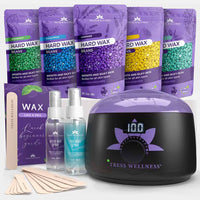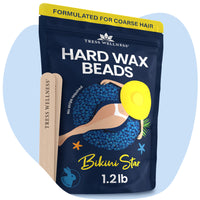Why Opt for Soft Wax for Hair Removal?
Soft wax is an alternative to hard wax for hair removal from large body areas. This article aims to provide guidance on selecting, applying, and caring for soft wax and compares it to hard wax to see which is better.
Key Takeaways
- Soft wax is a good alternative for hair removal on large body areas, offering versatile formulas suitable for different skin and hair types, and is known for exfoliating the skin while removing hair.
- The application of soft wax requires careful technique to be gentle and effective, and aftercare is crucial for maintaining skin smoothness, including cleansing, soothing, and using specific post-wax products to avoid irritation.
- Soft wax is ideal for large areas due to its efficiency and lower cost per session, while hard wax is preferred for sensitive areas due to its gentle nature and minimal skin adhesion, reducing discomfort and the risk of ingrown hairs.
Understanding Soft Wax: A Comprehensive Guide

The soft wax hair removal method remains popular for its exceptional grip on both skin and hair. It effectively tackles large body areas like the arms, legs, and back, offering a smooth finish. Soft wax's ability to remove hair from extensive surfaces makes it the ideal choice for larger body zones, promising a satisfying and skin-friendly experience.
What Is Soft Wax and How Does It Work?
Soft wax, also known as strip wax, is a malleable substance designed to attach to hair with precision. As it's spread onto the skin, it forms a thin layer, ready to be paired with wax strips. With each pull in the opposite direction of hair growth, soft wax ensures a hair-free, smooth canvas.
The Soft Wax Experience: Application and Techniques
Soft wax application requires precision and technique. It involves spreading the wax in the direction of hair growth and pressing a cloth strip firmly onto the waxed area. With a swift motion, the strip is pulled against the hair growth, ensuring thorough hair removal.
Preparing Your Skin for Soft Wax
Before you let the wax take the stage, your skin needs to be prepped for the main event. Here's a quick listicle to ensure you're ready for a smooth performance:
- Cleanse with Mild Soap: Wash away any sweat, oil, or residue for a pristine base. Think of it as the dress rehearsal before the show.
- Pre-Wax Lotion Magic: Apply a pre-wax lotion to soothe and shield your skin. It's like having a backstage crew looking out for you.
- Powder, the Absorbent Hero: Dust on some cornstarch to soak up moisture and create a barrier. It's the unsung hero that prevents sticky mishaps.
- Skip the Lotion: Before the wax's big entrance, keep your skin free of lotions. Let it be the natural canvas it was meant to be, ready for the waxing artist's deft touch.
With these steps, you're all set to transform your skin into a smooth masterpiece worthy of a standing ovation.
Aftercare Essentials: Maintaining Smooth Skin Post-Wax
Proper aftercare is essential for maintaining smooth skin after waxing. It involves cleansing the skin of any wax residue, followed by soothing products to reduce redness. Gentle exfoliation and hydration are crucial in the days following the waxing session.
Soft Wax vs. Hard Wax: Understanding Your Options

Soft wax and hard wax offer unique benefits. While soft wax is ideal for large areas, hard wax is preferred for sensitive areas due to its gentle nature. Both types of wax have their place in the hair removal process, catering to different needs and preferences.
Soft Wax vs Hard Wax
Soft wax covers larger areas efficiently, while hard wax is more suitable for sensitive zones. Hard wax's ability to grip hair without adhering to the skin minimizes discomfort and irritation.
Hard Wax Advantages: Why Some Prefer Beads to Strips
Hard wax beads provide gentle hair removal, adhering to hair rather than skin. They reduce discomfort and are ideal for sensitive areas. The benefits of hard wax beads don’t stop at their gentleness; they also play a pivotal role in reducing the likelihood of ingrown hairs, a concern that often shadows the hair removal process. When it comes to the detailed work of waxing sensitive zones, hard wax is the meticulous sculptor, chiseling away unwanted hair with a tender touch. When it comes to the detailed work of waxing sensitive zones, Tress Wellness Hard Wax steps up as your personal sculptor, meticulously chiseling away unwanted hair with a tender touch. Tress Wellness Hard Wax is a game-changer for those intimate and delicate areas, offering a low-temperature formula that comforts your skin while gripping the hair firmly.
Here's why you might prefer hard wax to soft wax:
@tresswellness_waxingkit Replying to @Alije👐 overall we think Hard wax is a lot better than waxing strips! It’s more gentle on trhe skin and it’s easier to use. #waxing #hardwax #waxstrip #howtowax #waxingforbeginners #waxingvideos #USA ♬ original sound - Tress Wellness Waxing Kit 💜
Pros and Cons of Soft Wax Hair Removal
Soft wax offers efficient hair removal for large areas and acts as a skin exfoliant. However, it may cause skin irritation and discomfort if not applied correctly. Soft wax requires precision and technique, along with additional costs for wax strips.
In Summary
Soft wax plays a leading role in hair removal, offering efficient results and skin exfoliation. However, it comes with considerations such as skin irritation and the need for precision. As you navigate your hair removal options, may this guide help you choose the right waxing style for your needs.
Frequently Asked Questions
What is the main advantage of using soft wax over hard wax for large body areas?
The main advantage of using soft wax over hard wax for large body areas like legs and arms is its efficiency in covering more surface area quickly, providing long-lasting results and effective removal of fine hairs.
Can soft wax be used on sensitive areas like the bikini line?
Using soft wax on sensitive areas like the bikini line is not recommended, as it may cause more pain and irritation compared to hard wax beads.
How can I ensure a smooth soft wax application?
To ensure a smooth soft wax application, spread the wax in thin layers in the direction of hair growth, press a cloth strip onto the wax, and swiftly pull it off against the hair growth while keeping the skin taut.
What are some aftercare tips for maintaining smooth skin after waxing with soft wax?
To maintain smooth skin after waxing with soft wax, remove any wax residue with oil, apply soothing products with antibacterial properties, wear loose clothing, and start gentle exfoliation and moisturizing 24 hours after waxing for the best results.
How does soft wax hair removal exfoliate the skin?
Soft wax adheres to both the hair and the top layer of dead skin cells, providing exfoliation and leaving the skin smoother and more radiant.




